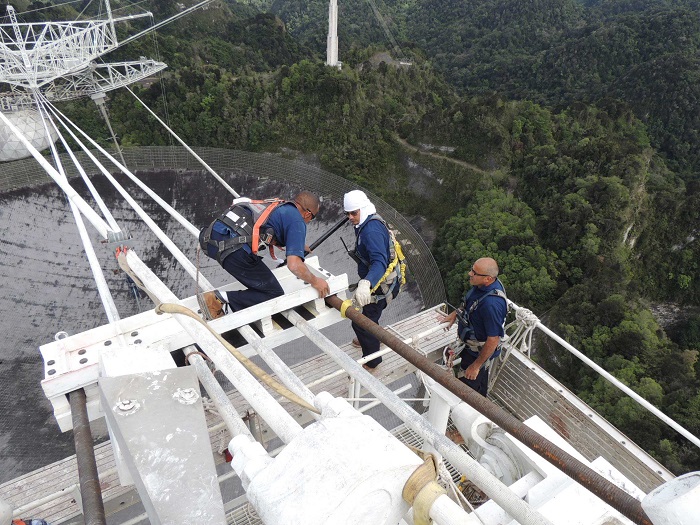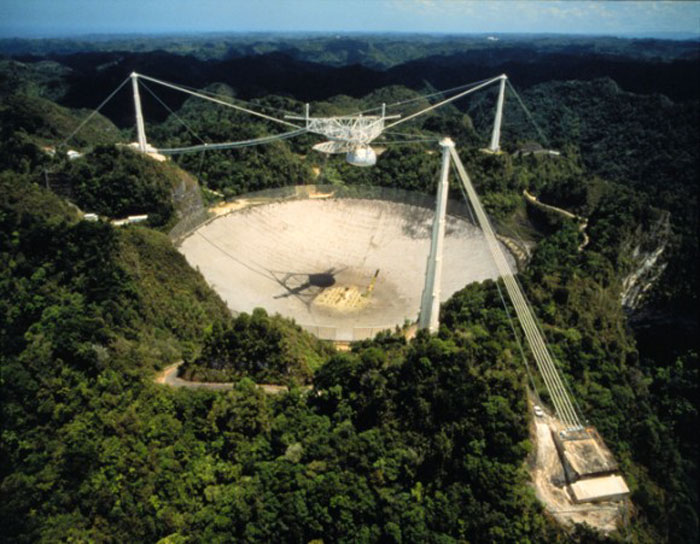The platform hangs above the Arecibo dish, supported by cables. Via Cornell University.
.
The famous radio observatory is located near Puerto Rico’s north coast, and opened in 1963. It was built inside a depression left by a sinkhole and is the largest curved focusing dish on Earth. The dish’s surface is made of thousands of perforated aluminum panels, each about 1 by 2 meters (3 by 6 feet), supported by a mesh of steel cables. The receiver is on a 900-ton platform suspended 137 meters (450 feet) above the dish by 18 cables running from three reinforced concrete towers.
It was one of these 18 cables that was damaged, and this particular cable was actually a known potential problem. Kerr said that during original construction of the telescope in 1962, one of the original platform suspension cables that was delivered to the observatory was too short, and another short cable section was “spliced” to provide sufficient reach to the platform.
“That cable segment and splice near the top of one of the telescope towers was consequently more rigid than the balance of the suspension system,” Kerr said. “When the earthquake shook the site, just after midnight on January 13, it is that short cable and splice that suffered damage.”
“You might say that our structural Achilles heel was exposed,” Kerr added.
Inspectors from New York’s Ammann & Whitney Bridge Construction, who have been inspecting the Arecibo observatory site since 1972, were brought in to access the situation. Kerr said a relatively low-cost (less than $100,000) repair option was designed, and materials are now being procured to complete a repair that is expected to bring the telescope back into full service.
“While the project awaits full review by the National Science Foundation, necessary steel materials for the repair are being shipped to the Observatory at this writing,” Kerr said. “Our estimated completion date for this project is March 11, 2014.”
This repair is considered temporary, however, and Kerr said a more comprehensive long-term cable repair design is being developed.
But the repair to the cable is by no means easy. The Arecibo Observatory maintenance staff will be doing the repairs themselves, working high above the ground on the 900-ton steel suspension bridge-like suspension system.
Kerr said they hope to complete this emergency repair “as expeditiously and safely as possible,” and that “it is testimony to the remarkable expertise, capability, and bravery of the Arecibo staff. I am dubious that a parallel capability exists at any other U.S. science facility.”
In the meantime, the telescope is being used only sparingly and with an “abundance of caution,” using only limited motion of the telescope. Kerr said that despite the damage, the telescope was able to continue its science mission by participation in a ten-day global ionospheric study in late January, in addition to continuing a search for pulsars in the sky above Arecibo, and searching for fast radio bursts (FRBs). Because radio telescopes can work at all times of day and in all kinds of weather, the observatory normally operates 24 hours a day. The Angel Ramos Visitor Center at the Observatory was closed for a few days, but reopened on January 22, with normal access and visiting hours.
The Observatory is recognized as one of the most important national centers for research in radio astronomy, planetary radar and terrestrial aeronomy. During its 50-plus years of use, findings from Arecibo have contributed to better understanding of the Earth’s atmosphere, the Moon, asteroids, other planets, exotic stars, our galaxy, and the large-scale galactic structure of the universe. The facility was featured in the movies “Contact” and “Golden Eye,” as well as dozens or TV shows and books, and is one of the most popular tourist attractions in Puerto Rico.
It is operated by SRI International, teaming with The Universidad Metropolitana and the Universities Space Research Association, in cooperative agreement with the National Science Foundation.
Quelle: UT
.
Update: 16.03.2014
.
Arecibo Observatory Main Suspension Cable Repaired Following Earthquake
.

Workers making repairs at Arecibo Observatory.
.
MENLO PARK, Calif. On January 13, 2014, the William E. Gordon radio telescope in Arecibo, Puerto Rico sustained damage following a 6.4 magnitude earthquake that was centered 37 miles northwest of Arecibo. Following the earthquake, Arecibo Observatory staff conducted a structural survey that revealed serious damage to a main suspension cable section, with apparent breach of several cable strands within that cable, which supports the 900-ton focal platform of the telescope. There are 18 main suspension cables in all.
A short cable segment and splice near the top of one of the telescope towers, which is more rigid than the rest of the suspension system, suffered damage when the earthquake shook Arecibo.
Ammann and Whitney Consulting Engineers were brought in to assess the damage and to consider repairs needed before the telescope could return to full operations.
“In an abundance of caution, telescope motion had been very limited since the earthquake,” said Robert Kerr, Ph.D., the Observatory's director and a principal scientist at SRI International, which leads a multi-organization team that manages, operates, and maintains the Arecibo Observatory. “Nevertheless, the telescope continued its science mission, including participation in a 10-day global ionospheric study in late January and continuing a productive search for pulsars in the sky above Arecibo.”
Arecibo Observatory has now completed the immediate repair of the William E. Gordon telescope. The repair design was created by Ammann and Whitney and the structural repair work was performed by Arecibo Observatory staff. Beginning on March 13, the telescope is back to full service for the scientific community.
The Arecibo Observatory is operated by SRI International, teaming with Universidad Metropolitana and the Universities Space Research Association, in a cooperative agreement with the National Science Foundation.
Quelle:



